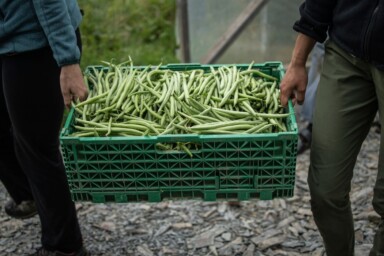As I wrote when the pandemic swept in, the uptake in our box scheme during the lockdown was extraordinary. Within two weeks from its start, it had tripled from our usual 60 or so boxes to 180. And through out the lockdown it stayed thereabouts. We had welcome and gratifying messages from our customers for our services – genuine appreciation for what we do and that we were there when they needed us.
From the start of all this, the question for us – and I’d venture to say, every other veg grower, small scale producer and local shop – was, will it last? Will this interest in local food stick?
The lockdown has definitely woken us up. Research carried out by You Gov for the Food, Farming & Countryside Commission has shown that people want to learn from this crisis and are trying different things – cooking from scratch, exercising more. It’s enhanced a sense of community, bringing people together even as they are separate. We’re more aware of nature and of how much better air quality has been because we’re not moving around so much. And, thankfully, it’s made us recognise how much we value food. The stats are hopeful, heartening and speak of change and transformation.
But change, we must all remember, is unabidingly hard, no matter how good it is ultimately. In the last week, I’ve witnessed the slow drip of customers leaving our box scheme: ‘We are not organic die-hards,’ said one, ‘but have enjoyed the change and variety’; another said ‘I’m just rethinking food and shopping now that I’m not working and I just can’t justify a veg box delivery at the moment’; a third, ‘Thanks so much for the boxes we’ve had, they were delicious. We are going to stop them for a while I’m afraid’, with no further explanation.
A good chunk of the people now leaving our box scheme have gardens that are starting to produce, so that’s a good thing – and many of them will come back in late autumn when their gardens slow down. They’ll also come to market through the summer and autumn to top up on the things they didn’t grow. But I suspect that in the coming weeks a lot of our customers will leave because life is gently returning to normal, to what they did before, and the supermarket is ever so much cheaper and you can buy whatever you want, from wherever you want at any time of year.
I know that expense is an issue in local food – whether you’re buying local vegetables, local cheese, local meat or local flour. It’s produced on an economic playing field that values economies of scale, efficiency and just-in-time logistics, so it’s bound to be on the downside of profit, demanding customers pay more. The problem is that turning this equation around is particularly difficult in our globalised, industrialised food system, where trade deals have the potential to trump environmentally-sound agricultural practice and high animal welfare. Everyone has to decide how they prioritise their food purchases based on what they can afford; but I do believe that many more people can afford to pay more for food that is produced more sustainably and with better animal welfare, but choose not to.
In a recent podcast, former Today host John Humphrys in conversation with SFT director Patrick Holden, argued that ‘The vast, vast overwhelming majority of people in this world…are concerned with two or three things: the first is that there is enough food when they [need] to buy; the second is that it be of reasonable quality; and the third is that it be of reasonable price. [People] couldn’t give a monkey’s as to where precisely that pear or apple or rice…came from [or] how it was grown. They see it, they need it, they buy it – and they will continue to do that unless and until something catastrophic happens.’ It’s a pretty bleak viewpoint, but one, I hate to admit, that is most probably true.
But here’s the thing: that catastrophic moment is not so far away, it’s just too big a catastrophe to take on board. We sit on a knife edge of calamity, teetering on tipping points – global warming, biodiversity loss, soil degradation, planetary boundaries, plastic in our seas and other less noted dangers. What we eat and how we feed ourselves is integral to how we solve the problems that we face; untangle this knot of issues and it will surely make the solutions to other problems easier to find.
But if we don’t use the pandemic to re-imagine what our future could be, then we are surely damned. The end of the lockdown with its promise of a return to normality holds both hope and blindness – we cannot go forward, looking back. This pandemic has revealed so much about our food system: that if we continue to destroy the wild places on the earth in the quest for industrialised food and the money which comes from it, we will have more pandemics that will, inevitably, be more dangerous; that supermarkets are not the bastions of food security that we may have thought; that citizens when faced with empty supermarket shelves will be resourceful and find alternative local routes to food that fills the gap. But will they remember how important their discovery was?
The small- and medium-scale farms and food businesses that serve their local communities need far, far more support and local food should be championed. But the vast majority of people have long since forgone local shops and producers for cheaper supplies in supermarkets – yet, if they aren’t supported, they won’t be there for the next pandemic. And what they offer is largely what we need most: businesses that value the quality of what they produce and whose practices are less impactful on the earth and countryside and who give considered care to the animals they raise. They produce food with a story – a provenance and place. And local purchases strengthen local economies. I hope that the experience of buying from them through the pandemic has made them more valued and increased respect for them.
So, remember that small and local producers are a good place to start for your food. And remember to reach a little further into your purse, if you can, to buy from them. If we leave it to the industrialised food system to feed the world, which it does rather little of in the big picture – most food in the world is produced by small-scale farmers – the next time a pandemic comes round we may find ourselves, as I said at the beginning of all this, ‘Nine meals from anarchy’.







